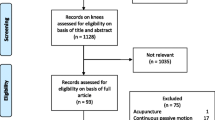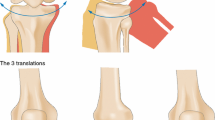Abstract
Purpose
The purpose of the study is to determine the effectiveness of semi-active and active robotic hip and knee arthroplasty on post-operative patient-reported outcomes of function, pain, quality of life and satisfaction with surgery.
Methods
PubMed, Medline, Embase and CENTRAL were searched. Included were comparative studies investigating the effectiveness of semi-active or active robotic hip or knee arthroplasty compared to any other surgical intervention on function, pain, quality of life and satisfaction with surgery. Risk of bias and the strength of the evidence were assessed using the Downs and Black tool and the GRADE system, respectively. Relative risks, mean differences and 95% CI were calculated using random-effects models.
Results
Fourteen studies involving 1342 patients were included. All studies compared robotic to conventional surgery, with active robotic surgery evaluated in total hip or knee arthroplasty and semi-active robotic surgery in total hip or unicompartmental knee arthroplasty. Most studies presented some risk of bias, and the strength of evidence was rated as low to very low quality. Random-effects meta-analyses showed that post-operative functional outcomes were comparable between active robotic and conventional total hip and knee arthroplasty at the short-, medium- and long-term follow-up. No significant difference in pain, quality of life and satisfaction with surgery were reported in individual studies.
Conclusions
This systematic and meta-analyses indicates that functional outcomes for patients undergoing active robotic total hip and knee arthroplasty were comparable to conventional surgery. Whether semi-active or active robotic hip or knee arthroplasty is effective in improving post-operative pain, quality of life and satisfaction with surgery is unclear.
PROSPERO Registration Number: CRD42017059932.



Similar content being viewed by others
References
Australian Orthopaedic Association National Joint Replacement Registry (AOANJRR) (2017) Hip, knee & shoulder arthroplasty: 2017 annual report. https://aoanjrr.sahmri.com/documents/10180/397736/Hip%2C%20Knee%20%26%20Shoulder%20Arthroplasty. Accessed 16 Apr 2018
Ethgen O, Bruyere O, Richy F, Dardennes C, Reginster J (2004) Health-related quality of life in total hip and total knee arthroplasty: A qualitative and systematic review of the literature. J Bone Joint Surg Am 86-A(5):963–974. https://doi.org/10.2106/00004623-200405000-00012
Xu K, Li Y, Zhang H, Wang C, Xu Y, Li Z (2014) Computer navigation in total hip arthroplasty: A meta-analysis of randomized controlled trials. Int J Surg 12(5):528–533. https://doi.org/10.1016/j.ijsu.2014.02.014
van der List J, Chawla H, Joskowicz L, Pearle A (2016) Current state of computer navigation and robotics in unicompartmental and total knee arthroplasty: A systematic review with meta-analysis. Knee Surg Sports Traumatol Arthrosc 24(11):3482–3495. https://doi.org/10.1007/s00167-016-4305-9
Jacofsky D, Allen M (2016) Robotics in arthroplasty: A comprehensive review. J Arthroplast 31(10):2353–2363. https://doi.org/10.1016/j.arth.2016.05.026
Picard F, Moody J, DiGioia A, Jaramaz B (2004) Clinical classification of CAOS systems. In: DiGioia A, Jaramaz B, Picard F, Nolte L (eds) Computer and robotic assisted knee and hip surgery, vol 1. Oxford University Press, New York, pp 43–48
Buza J, Waterlain A, Thakkar S, Meree P, Vigdorchik J (2017) Navigation and robotics in knee arthroplasty. JBJS Rev 5(2):e4. https://doi.org/10.2106/JBJS.RVW.16.00047
Karthik K, Colegate-Stone T, Dasgupta P, Tavakkolizadeh A, Sinha J (2015) Robotic surgery in trauma and orthopaedics: A systematic review. J Bone Joint Surg Br 97-B(3):292–299. https://doi.org/10.1302/0301-620x.97b3.35107
Lang J, Mannava S, Floyd A, Goddard M, Smith B, Mofidi A, Seyler T, Jinnah R (2011) Robotic systems in orthopaedic surgery. J Bone Joint Surg Br 93-B(10):1296–1299. https://doi.org/10.1302/0301-620x.93b10.27418
Porter I, Goncalves-Bradley D, Ricci-Cabello I, Gibbons C, Gangannagaripalli J, Fitzpatrick R, Black N, Greenhalgh J, Valderas J (2016) Framework and guidance for implementing patient-reported outcomes in clinical practice: Evidence, challenges and opportunities. J Comp Eff Res 5(5):507–519. https://doi.org/10.2217/cer-2015-0014
Atkins D, Eccles M, Flottorp S, Guyatt G, Henry D, Hill S, Liberati A, O'Connell D, Oxman A, Phillips B, Schunemann H, Edejer T, Vist G, Williams J, Grade Working Group (2004) Systems for grading the quality of evidence and the strength of recommendations I: Critical appraisal of existing approaches the GRADE working group. BMC Health Serv Res 4(1):38. https://doi.org/10.1186/1472-6963-4-38
Higgins J, Green S (2011) Cochrane handbook for systematic reviews of interventions. www.cochrane-handbook.org. Accessed 1 May 2017
Moher D, Liberati A, Tetzlaff J, Altman D, PRISMA Group (2010) Preferred reporting items for systematic reviews and meta-analyses: The PRISMA statement. Int J Surg 8(5):336–341. https://doi.org/10.1016/j.ijsu.2010.02.007
Downs S, Black N (1998) The feasibility of creating a checklist for the assessment of the methodological quality both of randomised and non-randomised studies of health care interventions. J Epidemiol Community Health 52(6):377–384. https://doi.org/10.1136/jech.52.6.377
Pynsent P, Adams D, Disney S (2005) The Oxford hip and knee outcome questionnaires for arthroplasty. J Bone Joint Surg Br 87-B(2):241–248. https://doi.org/10.1302/0301-620X.87B2.15095
Lingard E, Katz J, Wright R, Wright E, Sledge C, Kinemax Outcomes Group (2001) Validity and responsiveness of the Knee Society Clinical Rating System in comparison with the SF-36 and WOMAC. J Bone Joint Surg Am 83-A(12):1856–1864. https://doi.org/10.2106/00004623-200112000-00014
Moonot P, Medalla GA, Matthews D, Kalairajah Y, Field RE (2009) Correlation between the Oxford knee and American Knee Society scores at mid-term follow-up. J Knee Surg 22(3):226–230. https://doi.org/10.1055/s-0030-1247753
Singh J, Schleck C, Harmsen W, Lewallen D (2013) Validation of the Hospital for Special Surgery knee questionnaire: convergent validity, responsiveness and sensitivity to change. Paper presented at the American College of Rheumatology Annual Meeting, San Diego, CA, October 25–30
Singh J, Schleck C, Harmsen W, Lewallen D (2016) Validation of the Mayo Hip Score: Construct validity, reliability and responsiveness to change. BMC Musculoskelet Disord 17:39. https://doi.org/10.1186/s12891-016-0868-3
McGrory B, Harris W (1996) Can the Western Ontario and McMaster Universities (WOMAC) Osteoarthritis Index be used to evaluate different hip joints in the same patient? J Arthroplast 11(7):841–844. https://doi.org/10.1016/S0883-5403(96)80184-7
Bargar W, Bauer A, Borner M (1998) Primary and revision total hip replacement using the ROBODOC system. Clin Orthop Relat Res 354:82–91. https://doi.org/10.1097/00003086-199809000-00011
Honl M, Dierk O, Gauck C, Carrero V, Lampe F, Dries S, Quante M, Schwieger K, Hille E, Morlock M (2003) Comparison of robotic-assisted and manual implantation of a primary total hip replacement: A prospective study. J Bone Joint Surg Am 85-A(8):1470–1478. https://doi.org/10.2106/00004623-200308000-00007
Siebel T, Kafer W (2005) Clinical outcome following robotic assisted versus conventional total hip arthroplasty: A controlled and prospective study of seventy-one patients. Z Orthop Ihre Grenzgeb 143(4):391–398. https://doi.org/10.1055/s-2005-836776
Nishihara S, Sugano N, Nishii T, Miki H, Nakamura N, Yoshikawa H (2006) Comparison between hand rasping and robotic milling for stem implantation in cementless total hip arthroplasty. J Arthroplast 21(7):957–966. https://doi.org/10.1016/j.arth.2006.01.001
Hananouchi T, Sugano N, Nishii T, Nakamura N, Miki H, Kakimoto A, Yamamura M, Yoshikawa H (2007) Effect of robotic milling on periprosthetic bone remodeling. J Orthop Res 25(8):1062–1069. https://doi.org/10.1002/jor.20376
Nakamura N, Sugano N, Nishii T, Kakimoto A, Miki H (2010) A comparison between robotic-assisted and manual implantation of cementless total hip arthroplasty. Clin Orthop Relat Res 468(4):1072–1081. https://doi.org/10.1007/s11999-009-1158-2
Lim S, Ko K, Park C, Moon Y, Park Y (2015) Robot-assisted primary cementless total hip arthroplasty with a short femoral stem: A prospective randomized short-term outcome study. Comput Aided Surg 20(1):41–46. https://doi.org/10.3109/10929088.2015.1076044
Bukowski B, Anderson P, Khlopas A, Chughtai M, Mont M, Illgen R (2016) Improved functional outcomes with robotic compared with manual total hip arthroplasty. Surg Technol Int 29:303–308
Park S, Lee C (2007) Comparison of robotic-assisted and conventional manual implantation of a primary total knee arthroplasty. J Arthroplast 22(7):1054–1059. https://doi.org/10.1016/j.arth.2007.05.036
Song E, Seon J, Park S, Jung W, Park H, Lee G (2011) Simultaneous bilateral total knee arthroplasty with robotic and conventional techniques: A prospective, randomized study. Knee Surg Sports Traumatol Arthrosc 19(7):1069–1076. https://doi.org/10.1007/s00167-011-1400-9
Song E, Seon J, Yim J, Netravali N, Bargar W (2013) Robotic-assisted TKA reduces postoperative alignment outliers and improves gap balance compared to conventional TKA knee. Clin Orthop Relat Res 471(1):118–126. https://doi.org/10.1007/s11999-012-2407-3
Liow M, Goh G, Wong M, Chin P, Tay D, Yeo S (2016) Robotic-assisted total knee arthroplasty may lead to improvement in quality-of-life measures: A 2-year follow-up of a prospective randomized trial. Knee Surg Sports Traumatol Arthrosc 25(9):22942–22951. https://doi.org/10.1007/s00167-016-4076-3
Cobb J, Henckel J, Gomes P, Harris S, Jakopec M, Rodriguez F, Barrett A, Davies B (2006) Hands-on robotic unicompartmental knee replacement: A prospective, randomised controlled study of the Acrobot system. J Bone Joint Surg Br 88-B(2):188–197. https://doi.org/10.1302/0301-620X.88B2.17220
Coon T, Driscoll M, Horowitz S, Conditt M (2011) Robotically assisted UKA is more accurate than manually instrumented UKA. Int J Med Robot 7:50
Australian Government (2005) Impacts of advances in medical technology in Australia. Productivity Commission. https://www.pc.gov.au/inquiries/completed/medical-technology/report/medicaltechnology.pdf. Accessed 14 Nov 2017
American Joint Replacement Registry (2016) AJRR's patient-reported outcome measure guide. http://www.ajrr.net/images/downloads/Data_elements/AJRR_PROMS_GUIDE_2016_FINAL_4-5_FINAL.pdf. Accessed 14 Nov 2017
National Health Service (2017) Patient reported outcome measures (PROMs) in England: A guide to PROMs methodology. https://digital.nhs.uk/data-and-information/data-tools-and-services/data-services/patient-reported-outcome-measures-proms. Accessed 11 Feb 2018
International Consortium for Health Outcomes Measurement (2017) ICHOM: Hip & knee osteoarthritis data collection reference guide. vol 2.2.1. Massachusetts, USA
Rolfson O, Wissig S, van Maasakkers L, Stowell C, Ackerman I, Ayers D, Barber T, Benzakour T, Bozic K, Budhiparama N, Caillouette J, Conaghan P, Dahlberg L, Dunn J, Grady-Benson J, Ibrahim S, Lewis S, Malchau H, Manzary M, March L, Nassif N, Nelissen R, Smith N, Franklin P (2016) Defining an international standard set of outcome measures for patients with hip or knee osteoarthritis: Consensus of the International Consortium for Health Outcomes Measurement Hip and Knee Osteoarthritis Working Group. Arthritis Care Res 68(11):1631–1639. https://doi.org/10.1002/acr.22868
Carr A, Robertsson O, Graves S, Price A, Arden N, Judge A, Beard D (2012) Knee replacement. Lancet 379(9823):1331–1340. https://doi.org/10.1016/S0140-6736(11)60752-6
Pivec R, Johnson A, Mears S, Mont M (2012) Hip arthroplasty. Lancet 380(9855):1768–1777. https://doi.org/10.1016/S0140-6736(12)60607-2
Turktas U, Piskin A, Poehling GG (2016) Short-term outcomes of robotically assisted patello-femoral arthroplasty. Int Orthop 40(5):919–924. https://doi.org/10.1007/s00264-015-2786-7
Herry Y, Batailler C, Lording T, Servien E, Neyret P, Lustig S (2017) Improved joint-line restitution in unicompartmental knee arthroplasty using a robotic-assisted surgical technique. Int Orthop 41(11):2265–2271. https://doi.org/10.1007/s00264-017-3633-9
Author information
Authors and Affiliations
Corresponding author
Ethics declarations
Conflict of interest
Sascha Karunaratne, Michael Duan, Evangelos Pappas, Paul Stalley, Mark Horsley and Daniel Steffens declare that they have no conflict of interest.
Brett Fritsch owns stocks in Optimised Ortho and 360 Knee Systems; has performed consulting work for Optimised Ortho, 360 Knee Systems, Arthrex, Global Orthopaedics and Omni; and has received institutional support from Arthrex, Global Orthopaedics, Zimmer and Smith & Nephew.
Richard Boyle has performed consultancy work for Stryker, Adler, Signature and Global Orthopaedics and receives research assistance from Corin.
Sanjeev Gupta has performed consultancy work for Stryker, Depuy, Global Orthopaedics and Corin.
Electronic supplementary material
Online Resource 1
(PDF 193 kb)
Online Resource 2
(PDF 29 kb)
Online Resource 3
(PDF 162 kb)
Online Resource 4
(PDF 129 kb)
Online Resource 5
(PDF 58 kb)
Rights and permissions
About this article
Cite this article
Karunaratne, S., Duan, M., Pappas, E. et al. The effectiveness of robotic hip and knee arthroplasty on patient-reported outcomes: A systematic review and meta-analysis. International Orthopaedics (SICOT) 43, 1283–1295 (2019). https://doi.org/10.1007/s00264-018-4140-3
Received:
Accepted:
Published:
Issue Date:
DOI: https://doi.org/10.1007/s00264-018-4140-3




